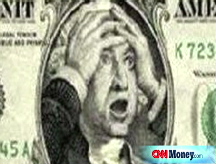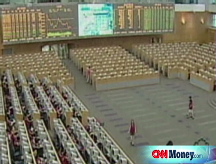The Fed's next move is...
Rate cuts and other decisive actions by the Fed might not be enough to revive the battered financial system. Here's what Ben Bernanke may try next.

NEW YORK (CNNMoney.com) -- No one can suggest the Federal Reserve has been sitting on the sidelines in the current financial crisis.
Just this week the Fed moved to pump potentially trillions of additional dollars into the nation's banks and leading corporations. And it led the way on emergency interest rate cuts by central banks around the globe Wednesday morning.
But experts say the Fed's actions may not be enough to stop the global economy from plunging into the worst downturn seen in at least 25 years, if not since the Great Depression.
Even those praising the Fed say it's not clear it has been able to stop the panic that has led to the freeze up of global credit markets and sent stock prices tumbling.
"I think they've been pretty inventive and pretty unrestrained," said Tom Schlesinger, executive director of the Financial Markets Center, a think tank that follows the Fed. "But I'm not sure what it would take to stem the fear in the markets. It's such a contagious and irrational phenomenon, and feeding on itself and compounding itself day by day."
On Tuesday, the Fed unveiled a plan to lend directly to the nation's major companies by buying up an unlimited amount of the $1.3 trillion in commercial paper, short-term loans that businesses use to operate day-to-day, on the market.
The Fed also announced it was doubling the size of its term auction facility, a program the Fed created last year to lend banks money for up to 85 days at a time, to $300 billion. The Fed added it was prepared to boost the term auction facility to $900 billion by year's end.
Despite this, banks still appear to be reluctant to lend money and stock markets around the globe continued to fall Wednesday.
Experts say there are worries that the global economy is now sliding towards recession and that there is relatively little that the Fed or other central banks can do to stop that. The International Monetary Fund warned Wednesday that the world's economy will slow sharply this year and next.
"They're looking a bit more impotent with each action," said Lakshman Achuthan, managing director of the Economic Cycle Research Institute, about the Fed.
Achuthan said that since major banks around the world are cutting back on their lending, that dwarfs the economic muscle of the world's central banks and governments.
But in a speech Tuesday, Federal Reserve chairman Ben Bernanke vowed that the Fed would do whatever it takes to try to fix the credit crunch.
"To support growth and reduce the downside risks, continued efforts to stabilize the financial markets are essential," he said. "The Federal Reserve will continue to use the tools at its disposal to improve market functioning and liquidity."
Experts say they don't think Wednesday's global rate cuts are the last steps the Fed plans to take. And many have suggestions as to what the Fed might do to get banks in the business of lending again.
The first step is probably the most traditional one - further rate cuts.
According to closely watched interest rate futures, investors are pricing in an 84% chance of another quarter point cut at the Fed's next meeting, a two day session that concludes on October 29. That would leave the central bank's key fed funds rate at 1.25%.
Many experts believe the Fed would not want to take rates below 1% -- which is where they were for 12 months in 2003 and 2004. Some have blamed those low rates for helping to create an environment of easy lending that contributed to the housing bubble.
Yet, the Bank of Japan's key interest rate is already at 0.5%. And some argue that it would be justified for the Fed to lower rates to that level, or even to 0%, because of current conditions.
"Why not? If you're facing a situation where you need to lower the rates all the way to zero to keep the economy from going over the precipice, why wouldn't you do that," said Lyle Gramley, a former Fed governor now working as an economist for the Stanford Group.
Regardless of how far the Fed is willing to cut, more cuts are expected by other central banks, most notably the European Central Bank. That's because the ECB had not been cutting rates during the past year and have more room to lower rates.
Bill Gross, the chief investment officer at giant bond manager Pimco, wrote this week that another step the Fed could take is to become a clearing house for trades of a variety of exotic and arcane financial instruments such as collateralized debt obligations or credit default swaps. These have traditionally been traded directly between two firms rather than in an open market.
"We believe that the Federal Reserve must now act as a clearing house, guaranteeing that institutional transactions clear," Gross wrote in his most recent commentary.
Schlesinger agreed, saying that while the Fed would normally never think to take such an active role in markets, these are far from normal times.
Gramley said he also believes that the Fed may supplement its efforts to help larger firms by starting to lend money to small and medium sized businesses as well.
The Fed could agree to buy small business loans from banks that are backed by collateral, such as inventories or equipment. Gramley said the loans could be purchased on a non-recourse basis, meaning the Fed, and not the bank, assumes the risk if the loan goes bad.
That would free the banks from the need to raise more capital if the loans sour and could make them more willing to make such loans once again.
"The Fed can work aggressively enough to break the logjam," Gramley said.
Still, Schlesinger is worried that there is little that the Fed or other government entities can do to fix the current crisis of confidence gripping financial markets.
A painful recession may be the only way for the markets to work the problems out of the system -- with further declines in housing prices and deeper job losses likely a result.
"I wish I had a silver bullet. But the fear is disconnected from underlying fundamentals at this point," said Schlesinger. "What will thaw it out is a sense among lenders that a modicum of trust has been restored in these complicated, opaque markets."
But Gramley said that even if recent or future actions by the Fed aren't enough to stop the economy from slowing further, they can still have a positive effect.
"Even if it's not going to prevent the recession from deepening, what it can prevent is a huge meltdown," said Gramley. ![]()






